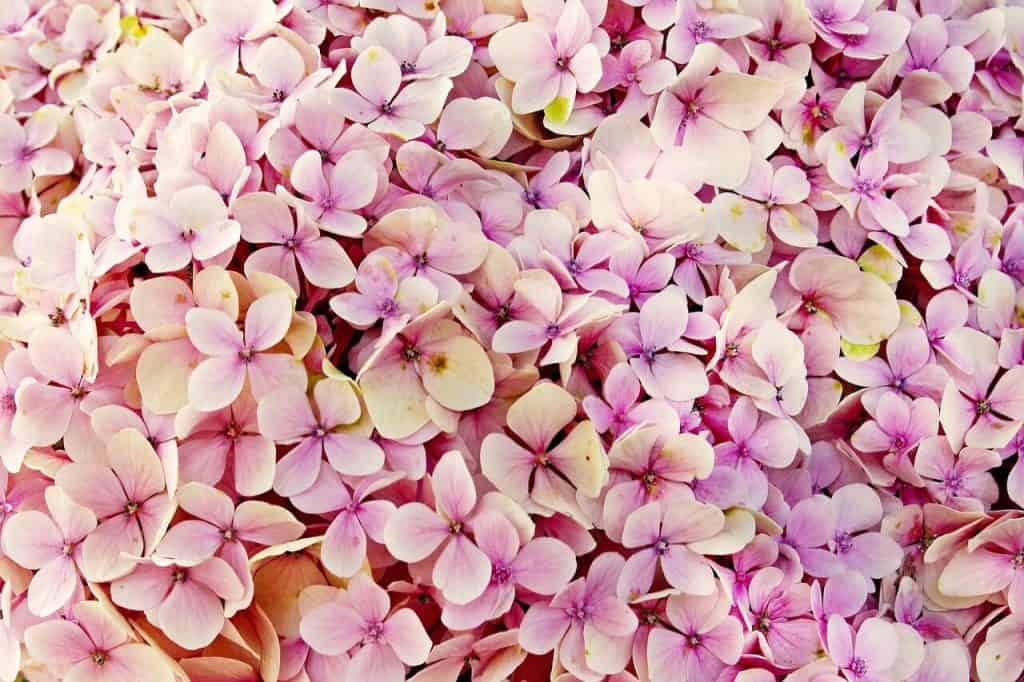Many of us are familiar with the shrub that produces round clusters of flowers that turn blue in acid soil and pink in sweet soil. Many times you hear people asking how can I turn my Hydrangea blue?
There are many different kinds of Hydrangea. The pink or blue balls of flowers are often refereed to as the Mop Head Hydrangea (Hydrangea maceophylla.) Sometimes these are called French Hydrangea. Most Mop Heads come in shades of pink,blue, violet and white. They produce large balls of flowers and are more dramatic and make a big statement in the garden. In my opinion these are the most difficult Hydrangea to grow. But as with many flowers it is location, location. They do better in acidity soils and are more difficult to grow in alkaline or sweet soils.
The larger leafed Oakleaf Hydrangea (H. quercifolia) is native to the United States. As their name infers, the thick leaves resemble those of an Oak tree . These easy to grow shrubs produce large white conical shaped clusters of flowers. They dry to a light brown. Some gardeners feel the Oakleaf Hydrangea is too big and to coarse for the garden. While pretty when it blooms, it really shines in the fall when the leaves turn a deep burgundy color. A new one for me is a double flowering variety called Gatsby Moon. The double florets produce huge and full coned shaped flower clusters.
Advertisement - Story continues below
Request advertising info. View All.
A favorite of mine are the Paniculata Hydrangea. They grow as a shrub or can be trained to grow as a small tree. These carefree shrubs produce loose clusters of cone shaped flowers. They start off as white and gradually turn to pink, red, or burgundy. Favorites are Pinky Winky, Fire and Ice, Strawberry Sundae, and others. A few years ago I went to a nursery with a female friend hunting for a new Hydrangea. I asked the young male staff person if he had a Pinky Winky. I’ll never forget the look on his face and watching my friend doubling over with laughter. Realizing how it must have sounded I turned as dark pink with embarrassment as the new variety of Hydrangea!
Another old fashion favorite is the smooth Hydrangea (hydrangea arborescens.) They are famous for producing huge round clusters of white flowers. These Hydrangea flowers cannot be changed to another color by adding acid to the soil. Older varieties would flop over, but newer ones like Incrediball, hold the flower clusters upright. There is also a pink blooming variety. I wish the pink color would last longer, but after a couple weeks the pink flowers age to a drab beige or brown. These shrubs bloom on new wood so it is a good idea to give it a trim in late winter or early spring.
A climbing Hydrangea, native to Asia is (Hydrangea petiolaris) not often seen in gardens. They produce loose clusters of smaller fragrant white flowers. It starts out slow, but after a few years it can grow to be 30 to 80 feet tall! It will tolerate shade, and in time become a very aggressive vine!
All Hydrangea are easy to grow and are hardy to zones 4 or 5. They need average soil and don’t like full sun in the afternoon. If they begin to wilt it is a sign they need more water. The larger leafed ones, like the Oakleaf Hydrangea tend to need more moisture. It is best to plant Hydrangea in the spring, but I have planted them later in the season and they have done well. Many people like cutting the dried clusters of flowers and use them in indoor arrangements or wreaths.
There are some gardeners who dislike the brown clusters hanging on the shrubs all winter. My dad enjoyed the rounded flowers of the Smooth Hydrangea and planted dozens of them. Mom disliked them and felt they were ugly. One year I came home for Thanksgiving on a cold bare November morning. As I drove up the long uphill drive to their home, I kept seeing bright orange flowers along the edge of their property. I couldn’t imagine what could possibly be blooming in the middle of fall. Under closer examination I discovered Mom had spray painted all the ugly brown flower clusters a bright orange! It certainly added to the Thanksgiving Festivities!
Ask the Gardener
If you have any gardening questions you would like to ask Rick or topics you would love to see him cover please feel free to drop him a note and ASK THE GARDENER here.
